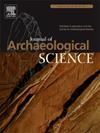迈向青铜制造的新历史:解释史前伊比利亚东北部锡青铜合金技术的选择(公元前2100-200年)
IF 2.5
1区 地球科学
Q1 ANTHROPOLOGY
引用次数: 0
摘要
铜锡青铜可以通过不同的工艺获得(即自然合金化、共熔炼、胶结、共熔炼和回收)。本文提出了一种方法和理论框架,以上下文解释在不同背景下青铜合金技术选择背后的逻辑,避免确定性,先验和线性叙述。为此,我们选择了伊比利亚东北部作为案例研究,并展示了公元前2100-200年间四个地点(Minferri、Vilars、Mas Castellar和Ullastret)的炉渣和结渣技术陶瓷的比较结果。使用pXRF, OM, SEM-EDS和ICP-MS对材料进行分析,以表征随时间变化的技术选择。选择的模式是根据每一种合金技术的技术能力来考虑的,并在相关的环境和社会经济参数范围内加以考虑。结果表明,青铜器制造技术的选择主要取决于(1)原材料采购网络的稳定性,以及(2)每种技术提供不同权衡的性能特征存在选择压力。这两个变量的离散组合可以解释不同技术共存的情况(例如Minferri, Mas Castellar和Ullastret)和承诺单一技术的情况(例如Vilars)。这是第一次通过对给定地区的青铜制造残留物的直接分析来调查青铜合金实践的历时性研究。所采用的分析框架和衍生的行为规则可以应用于其他案例研究,以共同构建青铜合金发展的多路径历史。这将是理解青铜合金技术选择与社会变革之间联系的基础,更好地将金属发现置于其生产和交换网络中,并重新质疑世界各地青铜生产组织和技术扩散的现有模式。本文章由计算机程序翻译,如有差异,请以英文原文为准。
Towards a new history of bronze making: Explaining the selection of tin bronze alloying techniques across prehistoric N.E. Iberia (2100-200BC)
Copper-tin bronzes can be obtained through different techniques (i.e. natural alloying, co-smelting, cementation, co-melting and recycling). This paper presents a methodology and theoretical framework to contextually explain the logic behind the selection of bronze alloying techniques in different contexts, avoiding deterministic, aprioristic and linear narratives. To do so, we selected Northeast Iberia as a case study and present comparative results of slag and slagged technical ceramics from four sites (Minferri, Vilars, Mas Castellar and Ullastret) dated between 2100-200BC. Materials were analysed using pXRF, OM, SEM-EDS, and ICP-MS to characterise technological choices through time. Patterns of choice are considered in relation to the technical affordances of each alloying technique and contextualised within the relevant environmental and socioeconomic parameters. The results show that bronze-making technique choices were primarily dependent on (1) the (in)stability of raw material procurement networks, and (2) the existent selective pressures on performance characteristics for which each technique offered different trade-offs. Discrete combinations of these two variables can explain instances of different techniques co-existing (e.g. Minferri, Mas Castellar, and Ullastret) and cases of commitment to a single one (e.g. Vilars).
This is the first diachronic study of bronze alloying practices investigated through direct analyses of bronze-making residues for a given area. The analytical framework employed and the derived behavioural rules can be applied to other case studies to collectively build a multi-path history of bronze alloying development. This will be fundamental to understand the link between bronze alloying technique selection and social change, to better contextualise metal finds within their production and exchange networks, and to requestion existing models of bronze production organisation and technological diffusion across the world.
求助全文
通过发布文献求助,成功后即可免费获取论文全文。
去求助
来源期刊

Journal of Archaeological Science
地学-地球科学综合
CiteScore
6.10
自引率
7.10%
发文量
112
审稿时长
49 days
期刊介绍:
The Journal of Archaeological Science is aimed at archaeologists and scientists with particular interests in advancing the development and application of scientific techniques and methodologies to all areas of archaeology. This established monthly journal publishes focus articles, original research papers and major review articles, of wide archaeological significance. The journal provides an international forum for archaeologists and scientists from widely different scientific backgrounds who share a common interest in developing and applying scientific methods to inform major debates through improving the quality and reliability of scientific information derived from archaeological research.
 求助内容:
求助内容: 应助结果提醒方式:
应助结果提醒方式:


